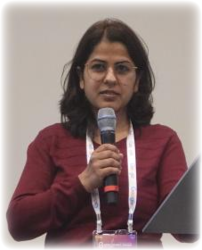LWN Articles About Kernel
-
SFrame: fast, low-overhead stack traces
Getting a stack trace of a running program is useful in a variety of scenarios: tracing, profiling, debugging, performance tuning, and more. There are existing mechanisms to get stack traces, but there are some downsides to them; the "Simple Frame" (SFrame) stack-trace format came about to address the shortcomings in the other techniques. Back in May, Steve Rostedt and Indu Bhagat gave a talk about SFrame support in the kernel as part of LSFMM+BPF; a few days later, Bhagat gave a more general talk about SFrame (YouTube video) at Open Source Summit North America in Vancouver. That second talk helped fill in some other aspects of SFrame and the overall stack-tracing picture.
-
Making life (even) harder for proprietary modules
The kernel community has never had a smooth relationship with the purveyors of proprietary kernel modules. Developers tend to strongly dislike those modules, which cannot be debugged or fixed by anybody other than their creator, and many see them as a violation of the kernel's license and their copyrights on the code. Nonetheless, proprietary modules are tolerated, within bounds. A recent patch from Christoph Hellwig suggests that those bounds are about to be tightened slightly, in a somewhat surprising way.
Back in 2006, there was a brief effort to ban the loading of proprietary kernel modules altogether. That attempt was shut down by Linus Torvalds for a number of reasons, starting with the fact that simply loading a proprietary module into the Linux kernel is, on its own, not a copyright violation; it is something that any Linux user is allowed to do. Trying to ban such modules, Torvalds said, would be an indication that the development community is more interested in arguing about licenses than in improving the technology.
Distributing a proprietary module might be a copyright violation, though, if the module itself is a derived work of the kernel code. But "derived work" is a fuzzy concept, and the kernel itself cannot really make that judgment. There is a longstanding mechanism in the kernel designed to keep infringing modules out, though: GPL-only exports. A kernel module cannot do anything useful without accessing symbols (functions and data structures) exported to it by the kernel. Many of those symbols are restricted to modules that have declared a GPL-compatible license, thus fencing proprietary modules away from a lot of kernel functionality.
-
Beginning the software-interrupt lock pushdown
The big kernel lock (BKL) is a distant memory now but, for years, it was one of the more intractable problems faced by the kernel development community. The end of the BKL does not mean that the kernel is without problematic locks, however. In recent times, some attention has been paid to the software-interrupt (or "bottom half") lock, which can create latency problems, especially on realtime systems. Frederic Weisbecker is taking a new tack in his campaign to cut this lock down to size, with an approach based on how the BKL was eventually removed.
The Linux kernel was initially developed on a uniprocessor system — understandably, since that was all any of us had back then — and the code was, as a result, heavily based on the assumption that it was running on the CPU and no others existed. The BKL was eventually introduced to enable Linux to run on those multiprocessor machines that, industry analysts assured us, would eventually be all the rage. It ensured that only one CPU was ever running kernel code at any given time, making all kinds of concurrency problems go away, but at a substantial performance cost, especially as the number of CPUs increased. It did not take long for the realization to sink in that the BKL had to go.
-
Shadow stacks for 64-bit Arm systems
Return-oriented programming (ROP) has, for some years now, been a valuable tool for those who would subvert a system's security. It is thus not surprising that a lot of effort has gone into thwarting ROP attacks, which depend on corrupting the call stack with a carefully chosen set of return addresses, at both the hardware and software levels. One result of this work is shadow stacks, which can detect corruption of the call stack, allowing the operating system to react accordingly. The 64-bit Arm implementation of shadow stacks is called "guarded control stack" (GCS); patches implementing support for this feature are currently under discussion.
A shadow stack is a copy of a thread's call stack; it is often (but not necessarily) maintained by the CPU hardware. Whenever a function call is made, the current return address is pushed onto both the regular stack and the shadow stack. When the function returns, the addresses at the top of the two stacks are compared; if they do not match, the system concludes that the call stack has been corrupted and, probably, aborts execution. This check is enough to defeat most attacks that involve writing a sequence of return addresses to the stack. Even if the shadow stack is writable, the need to update it to match the call stack raises the bar for a successful exploit considerably.

